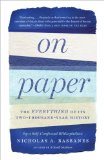Summary | Excerpt | Reviews | Beyond the Book | Readalikes | Genres & Themes | Author Bio

Critics' Opinion:
Readers' Opinion:
First Published:
Oct 2013, 448 pages
Paperback:
Jul 2014, 448 pages
 Book Reviewed by:
Book Reviewed by:
Bob Sauerbrey
Buy This Book
When the seventeenth-century patron of the arts Cassiano dal Pozzo set out to assemble a comprehensive collection of visual knowledge, he commissioned a number of prominent artists to make what turned out to be seven thousand watercolors, drawings, and prints in fields that included botany, art, architecture, geology, zoology, and ornithology. Dispersed today among four major institutional collections, what was arguably the world's first virtual library is known now as the Paper Museum. In more recent times, lithography and photography—the words literally mean "writing with stone" and "writing with light"— used paper as the surface of choice to create and distribute surrogate images.
As a force in shaping historical events, paper rarely draws attention to itself, yet its role is evident to varying degrees in scenario after scenario. One telling case in point is the introduction of human flight during the eighteenth century in France, when the Montgolfier brothers used several layers of paper made in the family mill to line the inner skin of the world's first hot-air balloon. Another example is the American Revolution; historians generally agree that the run-up to the Battles of Lexington and Concord can be said to have begun with the Stamp Act of 1765, which was all about taxing the many ways colonists had come to rely on paper documents in their daily lives. A century later, the refusal of Hindu and Muslim mercenary soldiers in the employ of the British East India Company to bite open paper cartridges greased with animal fat sparked a bloody insurrection known variously today as the Sepoy Mutiny and the First War of Indian Independence.
A roll call of political scandals, international incidents, and sensational trials to have paper documents at some point play a crucial role in the unfolding of events would have to include the Dreyfus affair of the 1890s and early 1900s, involving a forged memorandum known as the bordereau; America's entry into World War I, with the Zimmermann Telegram; the Alger Hiss spy case of the late 1940s, which involved the damning testimony of Whittaker Chambers regarding the notorious Pumpkin Papers; the trial of Julius and Ethel Rosenberg in 1953, with its purloined sketch of a nuclear implosion device that was crucial in sending both off to the electric chair; and Watergate, precipitated by Daniel Ellsberg's brazen release in 1971 of the Pentagon Papers. And while the influence of computers is everywhere apparent, it is instructive to note that the earliest machines of any functional significance processed their data on punched paper cards, and that the progenitor of all electronic printing devices—the universal stock ticker—used narrow spools of newsprint to give real-time readouts of financial transactions, revolutionizing forever the way business would be conducted on Wall Street.
Not only are we awash in a world of paper; we are awash in a world of paper clichés. George W. Bush defeated Al Gore in 2000 by a "paper thin" margin, the deceit that surrounded the Enron fiasco was built on a "tissue of lies," and the fragile structure that subsequently collapsed was a "house of cards." To beat someone to a "pulp" is to inflict appalling injury. To "map out" a plan for something is to come up with a spe cific course of action. Day in and day out, we are mired in "red tape," a corollary of being "buried under a mountain of paper," while a "paper tiger" is either a wimp or a weakling or a fraud, take your pick. I readily admit to playing with a few of them in this book—something being "not worth the paper it is printed on" was irresistible, and it provided the premise for the chapter I call "Face Value."
At the very time I was completing the first draft of this manuscript, the Boston Red Sox—a team I have been following obsessively since my father took me to Fenway Park for the first time in 1953—finished the most spectacular flop in the history of Major League Baseball, squandering a seemingly insurmountable lead of nine games with less than a month to go in the 2011 season and finishing entirely out of the playoffs. Making their collapse doubly painful were predictions made at the start of the season that, with fifteen highly paid All-Stars in the lineup, Boston was by far the best team to take the field that year. Sports Illustrated had picked the Red Sox to win one hundred games and handily dispatch the San Francisco Giants in the World Series; even seasoned sportswriters in New York, home of the archrival Yankees, were impressed by their prospects for a championship.
Excerpted from On Paper by Nicholas A. Basbanes. Copyright © 2013 by Nicholas A. Basbanes. Excerpted by permission of Knopf, a division of Random House LLC. All rights reserved. No part of this excerpt may be reproduced or reprinted without permission in writing from the publisher.





The Funeral Cryer by Wenyan Lu
Debut novelist Wenyan Lu brings us this witty yet profound story about one woman's midlife reawakening in contemporary rural China.
Your guide toexceptional books
BookBrowse seeks out and recommends the best in contemporary fiction and nonfiction—books that not only engage and entertain but also deepen our understanding of ourselves and the world around us.